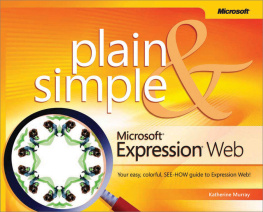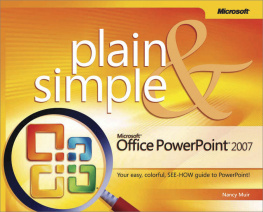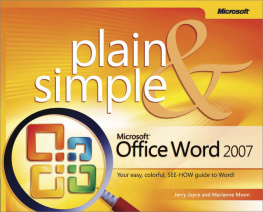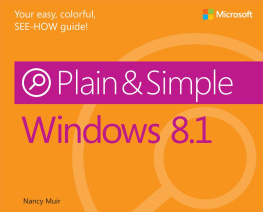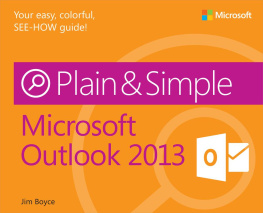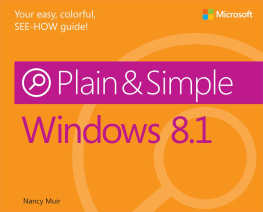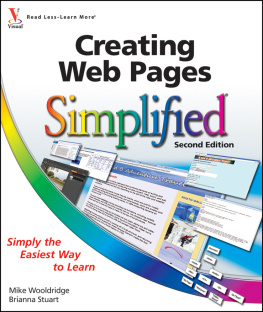Get the fast facts that make learning Microsoft Expression Web plain and simple! This no-nonsense guide uses easy numbered steps and concise, straightforward language to show the most expedient ways to learn a skill or solve a problem.
" name="description"/>
Microsoft Expression Web Plain & Simple: Your easy, colorful, SEE-HOW guide to Expression Web!
Katherine Murray
Published by Microsoft Press
Dedication
To Mike Reeds, because hes the one who suggested I write a book about this great program, and For my Dad, because he would have had a blast with Expression Web. We miss you Pop.

Jack Hawthorne June 1932April 2007
Acknowledgments
Every book is really a mix of talents and voices and abilities, and thats what I love about publishing. You have a whole group of people around you as you begin to create your first web page with Expression Web, and each person had an important part to play. Big thanks go to
Juliana Aldous Atkinson, Microsoft Press Acquisitions Editor extraordinaire, for loving the idea for this book and whole-heartedly wanting to publish it,
Claudette Moore, my agent, for making things happen in such a wonderful and always supportive way,
Sandra Haynes, for spearheading this project initially, offering feedback, and lots of encouragement,
Kathleen Atkins, project editor, for managing everything so well and keeping things flowing (quickly!),
Nan Brooks, copy editor, for doing such a good job of catching the goofs, cleaning up phrases, and making sure everything reads well,
Joell Smith-Borne, project editor, for her tireless work in overseeing the project and keeping us faithful to the conventions,
James Lissiak, technical editor, for going so carefully through every line of the manuscript and offering suggestions and tips,
Debbie Berman, compositor, who may have spent as much time with this book as I did, pouring her heart and considerable design talent into the beautiful pages you see today,
Debbie Abshier, of Abshier House, for her experience, humor, kindness, and in-the-trenches knowledgeand, last in the process, but not in any way least,
Kelly Quirino, proofreader, for a heroic, high-pressure proofreading pass, done almost at the very last moment!
I enjoyed working with all of you and hope we will work together on another book soon!
Chapter 1. About This Book
In this section:
At last! Web design for the rest of us.
Over the last 10 years or so, youve probably noticed the Web exploding all around you. You may have tried your hand at creating a few sites. Perhaps you even learned your way around Microsoft FrontPage and figured out enough about Web design to hang a shingle on the Web.
In the early days of the Web, sites consisted of mostly text and hyperlinks with a few pictures scattered here and there. The text was usually displayed as bulleted lists or long paragraphs; the images were cartoonish graphics with a few photos thrown in for extra impact. Todays Web is a dramatic improvement over the limited capabilities of the early daysnow in addition to text, you find streaming video, sound, high-quality photos, color, chat, podcasts, calendars, interactive forms, and just about anything else you can imagine.
You might think that creating one of these media-rich sites would be a challenge way beyond the capabilities of a beginning Web designer, but if youve got the right tool, youre halfway there.
And the right tool, of course, is Microsoft Expression Web.
Microsoft Expression Web is Microsofts answer to the next generation of feature-rich, standards-based Web design. Using Expression Web, you can create anything from simple, no-nonsense Web sites to sophisticated sites that make the most of a variety of media, include e-commerce features, interact with databases, and much more. Whether you are an experienced professional Web designer or someone who is just getting started designing your first site, Microsoft Expression Web gives you a full set of powerful tools and the support to help you plan, design, create, enhance, and publish sites that naturally conform to todays Web standards.
What Happened to Microsoft FrontPage?
Microsoft FrontPage has been Microsofts Web design product for almost a decade, but todays Web calls for a new set of tools. FrontPage was a great product in its own right, enabling designers to produce top-quality sites of all kinds, but FrontPage has been discontinued and will not be going through any future revisions. Microsoft Expression Web includes and extends the best features of FrontPage for the professional Web designer. For Web professionals working with SharePoint sites, Microsoft now offers Microsoft Office SharePoint Designer 2007, and for Web developers working with ASP.NET, Microsoft suggests Microsoft Visual Studio 2005.
What Youll Find Here
Microsoft Expression Web Plain & Simple is the book for you if you want to learnwithout a lot of fuss and fanfarehow to create great Web sites using Microsoft Expression Web. The format is full-color, informative, and clear: you can find what you need easily and put the steps directly into practice. Thats the best way to learn anyway.
Each section covers a different aspect of Web page creation, arranged in a logical sequence so that you can follow along reading one right after another if thats your style. But dont feel limited by the formatif you prefer to pick and choose your topic, skipping around in the book to read only what you need, by all means do that! Each section is presented in a series of short (two-page) tasks, so you can easily jump from item to item as your interest dictates.
introduces you to the lay of the land. Youll find out how to start Microsoft Expression Web, find your way around the screen, explore the tools, display different views, use shortcut keys, and get help when you need it.
is all about creating that first Web site. In this chapter, you learn how to plan your new site and then create it. Youll find out about various ways to create the site: starting with a blank page, using a template, or importing an existing site. Once you have created your site, you learn how to track site information and set your Web preferences.
focuses on the individual Web pageone page of your overall site. In this section, you learn how to manage your pages (by opening, renaming, saving, and deleting them), as well as how to decorate the page background, preview your pages, and use Dynamic Web Templates to automate page generation for pages that will share common elements.
are all about the content. Here you learn how to add text and pictures to your Web pages and enhance them using a variety of simple techniques: create bullet lists, change font and format, tweak the alignment, do simple editing, run the spelling checker (dont forget!), and control text wrap around images. Its all pretty straightforward, wrapped up nice and neat in these two key sections.
shines a spotlight on the prima donna of the Web page: the link. The Web wouldnt exist without what we once called the hyperlink the hot spot on your page (text, image, or button) that users click to move from one page to another. This section shows you how to add links to any and all elements on your page, and shows you how to troubleshoot and repair them when they dont seem to be working properly.
will be a treat for those of you who like your information organized and neatly structured because it shows you how to create tables for your pages. Knowing how to create a table for your Web page is a great tool to have in your designers toolkit. Tables enable you to create a structure for information that gives it boundaries, which is a nice thing when you are designing a page that will be viewed by people all over the world with all sorts of different Web browsers.

